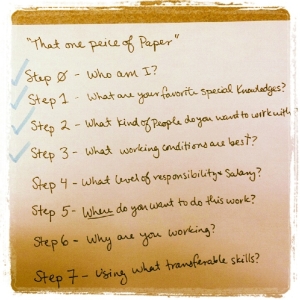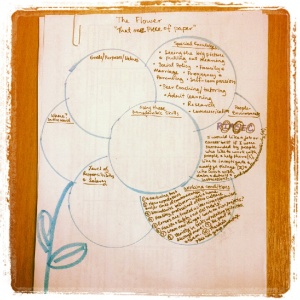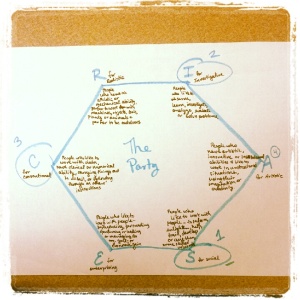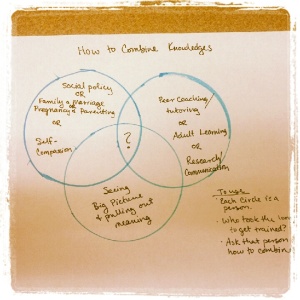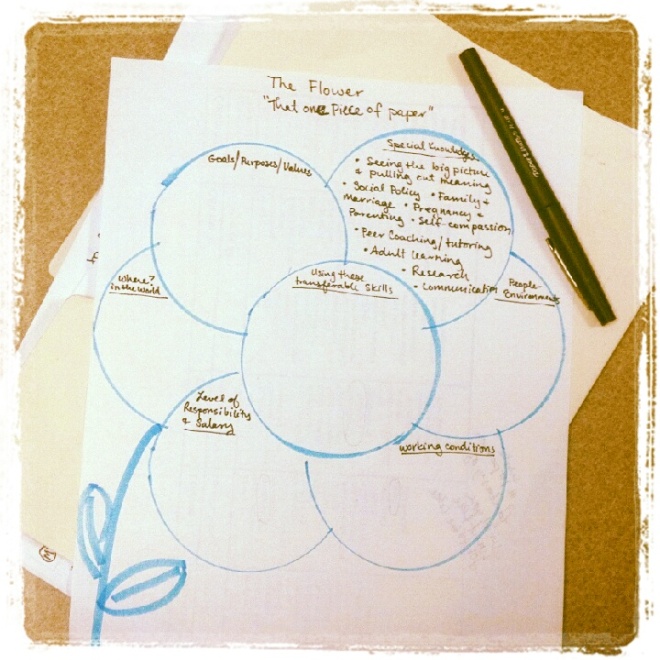 Step 4 is called, “What Level (Of Responsibility) do you Most enjoy working at, and at what salary?”
Step 4 is called, “What Level (Of Responsibility) do you Most enjoy working at, and at what salary?”
The instructions say:
Salary is something you must think out ahead of time, when you’re contemplating your ideal job or career. Level goes hand in hand with salary, of course.
1. The first question here is at what level you would like to work, in your ideal job? Level is a matter of how much responsibility you want, in an organization:
- Boss or CEO (This may mean you’ll have to form your own business)
- Manager or someone under the boss who carries out orders
- The head of a team
- A member of a team of equal
- One who works in tandem with one other partner
- One who works alone, either as an employee or as a consultant to an organization, or as a one-person business
Enter a two- or three-word summary of your answer, on the Level of Responsibility and Salary petal of your Flower Diagram.
This is easy. Having already noted that working by myself or with one other (occasionally) was miserable enough to end up on my working conditions list, the bottom two options are out. My summary on my flower will be: Manager, team leader, and/or a member of a team of equals.
However, salary is harder.
2. The second question here is what salary would you like to be aiming for?
Here you have to think in terms of minimum or maximum. Minimum is what you would need to make, if you were just barely “getting by.” And you need to know this before you go in for a job interview with anyone (or before you form your own business, and need to know how much profit you must make, just to survive).
Maximum could be any astronomical figure you can think of, but it is more useful here to put down the salary you realistically think you could make, with your present competency and experience, were you working for a real, but generous boss. (If this maximum figure is still depressingly low, then put down the salary you would like to be making five years from now.)
Make out a detailed outline of your estimated expenses now, listing what you need monthly […].
 I could type you the list from the book, but that seems a little boring to me, and in my opinion, it wasn’t very complete. I like the list I found here after a little Google digging: Free Sample Monthly Budget Template. I wouldn’t download anything from that site, but I like the list.
I could type you the list from the book, but that seems a little boring to me, and in my opinion, it wasn’t very complete. I like the list I found here after a little Google digging: Free Sample Monthly Budget Template. I wouldn’t download anything from that site, but I like the list.
I pulled out our YNAB4 budget, I asked Tim to pull out his pay stub, and I opened up our electronic bill pay and accounts to figure out how much we’ve been spending in each category, and filled out my spread sheet.
(Apologies with not sharing the numbers, but I am sensitive to potential comparisons.)
Next steps:
Multiply the total amount you need each month by 12, to get the yearly figure. Divide the yearly figure by 2000, and you will be reasonably near the minimum hourly wage that you need. […]
Parenthetically, you may want to prepare two different versions of the above budget: one with the expense you’d ideally like to make, and the other a minimum budget, which will give you what you are looking for, here: the floor, below which you simply cannot go.
My income from this career will be the second income in my family. We live comfortably on my partner’s income, and don’t have any interest in having more stuff, or “increasing” our standard of living (though, my knowledge of economics says that is inevitable). Having a small child, we’re going to incur the expense of child care when I work, which is my major concern with salary. And, it would be nice to lower our debt load, and save for emergencies, vacations, and retirement.
I need to work for personal security reasons — Working now will make sure that I have a good retirement income, either from savings or social security. Working is important, in case of the contingency that my husband dies, because entering the job market is difficult, especially after a long break. Also, knowing these numbers is critically important to valuing my own work. I deserve a salary for skilled, educated and qualified workers.
I decided, using math, and considering above, that my contribution salary would need to be approximately $40,000 per year at the low end. Using a little bit of research (on salary.com and cbsalary.com), I found that the upper quartile of people with “Program Assistant” jobs (which is a title I could have) is probably about $75,000.
[Aside: This is so privileged! I’m talking about making four to seven times the poverty level for one person ON TOP of the salary of my partner. Not only is it a privilege to know how much money you’re going to make in a year (i.e. not have to fight for hours), this is before/including benefits like paid vacation and insurance. We so need to put policies in place for the women who cannot make this choice between staying home and working, because working is an economic necessity.]
Finally, the book talks about an optional exercise in which you think about other rewards, besides money, that you hope for — nontangibles that can’t be converted to cash. These include: Adventure, popularity, intellectual stimulations from the other workers there, a chance to be creative, etc.
Adventure is one of my family values, so I’m going to add that to my flower. Intellectual stimulation from the other workers sounds like a nice benefit. And a chance to help others is important to me.
Now my flower looks like this:











